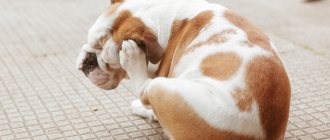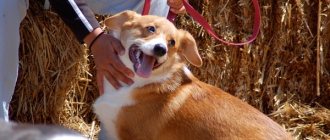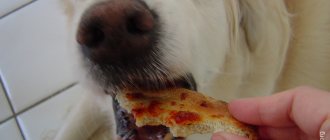Reasons for running away on the street
While walking the dog, the owner establishes close contact with the pet, teaches useful skills and commands. At the same time, many owners are familiar with the situation when, during a walk, the dog runs home, runs in an unknown direction, absolutely not reacting to the name, commands, or indignant exclamations of the owner.
The main reasons for a dog to run away on the street:
- improper adaptation, socialization;
- errors in education;
- cruel, rude, or improper treatment of a pet;
- spoiled;
- passion, curiosity;
- fear, fright, emotional experience;
- freedom-loving, dominant character;
- predisposition to a free life;
- insufficient duration and activity of walks.
Important! As a rule, puppies up to 5-6 months old do not run away from their owners during walks as often as their adult relatives. According to statistics, the most “lost” dogs are dogs from 8-12 to 15 months. Hyperactive, overly inquisitive dogs, representatives of hunting breeds, and hounds are especially prone to escape.
Most often, hunting dog breeds run away due to their developed instinct. For example, a dog saw a cat or a bird and decided to run after the so-called prey, realizing his potential as a hunter.
Dogs with an easily excitable psyche can also run away from their owner. The dog may become excited when he sees a cyclist, a car, or becomes interested in other dogs or animals on the street. It is possible that the pet was alarmed or frightened by something, so the dog rushed home as fast as he could.
If the dog does not come after being called, perhaps when the dog came, you punished him. Dogs are good at remembering negative actions on the part of their owners, and if a pet runs away or refuses to approach you, it means that it is afraid that it will be punished.
Important! If the dog is guilty, after he approaches you, do not shout, do not hit, do not punish him. You undermine your authority by losing contact with the animal.
If the dog runs towards other dogs, it may be that he lacks communication with his relatives. This behavior can be caused by banal disobedience, ignorance of commands, or insufficient activity.
Dogs often run away during the rut. Instincts dictate, therefore, sensing a bitch in heat, the male will follow her and become uncontrollable. During the period of sexual hunting, not only the hormonal levels of animals change, but also their behavior.
Dogs, in most cases, do not like a leash. After all, it is this attribute that hinders freedom of action. Therefore, when you call your pet to you and plan to finish your walk, do not fasten the leash right away. The dog’s reflex is reinforced: once the owner called and fastened the leash, it means the walk is over and you need to return home.
Don't forget that puppies and active young dogs can walk until they get tired or hungry.
Finding out the reasons for the escapes and further actions
In order to prevent your pet from running away, you must first understand what motivates your dog to run away.
Fear
- A dog can remember the place where something scared it, and subsequently try to run away from it every time. In this case, you need to find out what kind of place this is and try to create a different route for walking;
- If you live outside the city, try to create a secluded place at home for your dog where he can hide. Then you will know where to look for her if she gets scared of anything;
- The animal may also be afraid of loud sounds (car horns, pyrotechnic explosions, thunderclaps). Then you should take the dog away from the source of the sound as soon as possible.
The dog is bored
- If the dog runs away in your absence, then it is probably very bored and goes in search. In such a situation, you need to try to entertain your pet while no one is home. You can hide treats in different parts of the house, buy your pet new toys, or even make him a friend;
- If your dog is overly nervous, you should consult a veterinarian who will prescribe a course of special calming medications. However, under no circumstances should you treat your pet yourself;
- A dog can also run away because it doesn’t waste its energy, and it’s boring for it to sit alone at home. In this case, in addition to the previous advice, you should actively play with your pet more often or, for example, go for a run with him every morning.
Curiosity
Often the reason for a pet's escape from the yard of a private house may be its excessive curiosity. When interested in something, a dog can dig under a fence or even jump over it. If you know that your pet is capable of forgetting about everything when he notices a cat, a large car, or a passerby with food, then you need to try to make sure that the dog can always find something interesting in the yard. You can hide treats (but not on the ground) or toys, it is important to remember to leave enough water.
Simple rules of behavior when walking with a dog
Walking with your beloved pet should be exciting, active, interesting and safe, both for your dog and for strangers, other dogs, and animals.
To properly organize a walk, consider simple rules of behavior when walking with a dog:
- You can walk your dog only in specially designated areas. Cities have equipped, fenced areas for walking animals. If there are none, you can walk your dog in forest plantations and remote areas of the park.
- You cannot walk your pet in public places, on beaches, playgrounds, gardens, and sanatoriums. In the city, the dog must be on a leash and muzzled. Small dog breeds and puppies up to 4-5 months do not need to wear a muzzle.
- Never let your dog off the leash near highways or roads, even if the pet perfectly follows commands. The dog may get carried away with something and not respond to your call.
- When walking, always monitor what your pet is doing. The dog can show interest in strangers, scare a child, or pick up a harmful “treat” from the ground.
- Be sure to teach your dog to follow basic commands (“come to me”, “near”, “fu” or “no”).
- For walks in the summer, take a bowl and drinking water. In winter, before going outside, to protect the paw pads from the chemicals that are sprinkled on the sidewalks, lubricate them with protective cream, wax, or buy shoes for your pet for winter walks.
- In hot weather, monitor your level of physical activity. This is especially true for brachycephalic dogs and long-haired breeds.
- Never call your dog to you in a threatening tone, even if the dog has done something wrong.
- Do not let your dog go in unfamiliar places.
- If a dog runs away, carried away by something, and does not respond to a nickname, the effect of surprise will help to return the fugitive. Throw keys at the animal, hang it, clap your hands.
The first walks with the puppy should take place in quiet, calm places, away from dogs, people, and other animals. Nothing should scare a small pet, otherwise, being frightened by something, the dog will subsequently run away from you home or in an unknown direction.
Until your little pet gets used to the street, walk him on a leash. Walking should take no more than 15-20 minutes. Gradually increase the time, paying special attention to proper socialization of the dog.
On walks, you are not the only one who must monitor the animal’s actions. The dog must be afraid of losing sight of you. Therefore, play hide and seek with the animal; if the dog is passionate about something, attract his attention, call him to you.
How to stop a dog from running away from its owner
In order to eliminate the dog's habit of running away, the owner must switch the dog's attention to himself. It is necessary to form a new behavioral stereotype in which the pet is forced to constantly monitor the owner. This can be done in a simple way, which is the most effective in preventing escapes.
The method is called “ hide and seek ”: while walking in a deserted place, you need to hide behind the nearest bush or sit behind a tree, unnoticed by the dog, with a treat in your palm. Be sure to see your pet at the same time. Next, say his name out loud. The dog will definitely start looking for his owner, and when he finds him, he will be very happy. When leaving the shelter, you need to rejoice wildly with the dog, praise and treat it.
On every walk, you need to periodically hide from the dog until it gets used to constantly watching the owner. The game can be complicated by hiding more carefully, without giving the nickname, until the dog himself discovers the loss. For dogs who are distrustful of strangers, the exercise can include a sudden “attack” by an attacker on the owner while the dog is serenely sniffing the bushes. Before this, the dog is placed on a long leash.
Teaching the dog the “Come to me” command
The dog, regardless of breed, must be trained and clearly follow basic commands, such as: “Near”, Fu”, “No”, “Place”, “Come”. Not all dogs make ideal students, especially those with inexperienced owners.
Advice! If you do not have animal training skills, you have your first dog, or your pet is very disobedient, seek help from a dog trainer. The specialist will find an approach to the dog and select the optimal training system.
We teach the dog the “Come to me” command:
- We conduct the first lessons on a long canvas leash. For large dogs, you can also use a strict collar during classes.
- As soon as the pet is a short distance from you, after a few seconds say the pet’s name and give the command in a strict, confident intonation.
- If the dog does not respond, pull the leash towards you.
- You can attract your dog's attention with a treat. As soon as the dog approaches, praise him and give him a treat. Always give your dog different treats. Alternate treats with rewards.
- In the future, replace the treat with praise so that the animal does not constantly associate the call with food.
- Once the dog begins to understand and follow the “come to me” command, begin training without a leash.
- Practice the command in different places and situations.
During your walk, repeat the command “Come to me” several times. Always praise your dog for doing the right thing. When the dog is walking without a leash and runs towards you, give the command “Come to me” several times during the walk.
Do not give a command when your pet is very passionate about something, especially in the first lessons. The dog must be focused on the training process. Attract the dog with a nickname, a treat, pull the leash, and when the dog looks in your direction or walks towards you, say a command in a clear intonation.
Important! The “Come to me” command should not be associated with punishment or something unpleasant for the pet. For example, do not call your dog if you are planning to cut its nails, clean its ears, or perform other hygienic or medical procedures that are not very pleasant for the pet.
Knowing the “Come to me” command, if the dog follows it unquestioningly, you don’t have to worry about the safety of your pet.
Safety in the yard
A dog can run away regularly only if it has the opportunity to do so. To avoid this, the territory in which she spends most of her time must be as fortified as possible and isolated from the outside world.
- Usually the main escape route is through the fence. The dog can make tunnels, climb onto low nearby objects and jump over them, can crawl through holes and even open doors. To prevent this from happening, it is important to ensure the integrity of the fences and that nothing helps the animal overcome them;
- Hunting dog breeds are distinguished by their love of digging, and they dig quickly. To protect your pet from escaping, it is necessary to properly strengthen the fence. The easiest way is to lay large stones along it. You can also place a wire mesh under the fence to prevent your pet from getting out;
- Some representatives of large breeds can easily overcome a fence that is twice their height; this is important to take into account when building it. Its surface can be made uneven or curved inward so that the dog cannot get caught.
Subscribe to the newsletter and receive a discount at the pet store “Lubimchik”
Thank you for subscribing!
How to properly punish a dog for disobedience
Inappropriate behavior and disobedience can only be prevented by a properly organized training system. But it happens that the dog has mastered the commands perfectly, but refuses to carry them out, shows disobedience, demonstrates his freedom-loving character, behaved incorrectly on a walk, at home, the pet must be punished. To achieve the desired effect, you need to know how to properly punish a dog for disobedience:
- The maximum permissible actions are a slap with a newspaper, a click on the nose, a shake by the scruff of the neck.
- Never hit your dog with a leash. This accessory should evoke only positive emotions in your pet.
- The dog must be punished at the moment of committing an offense. Show your dissatisfaction. Scold your pet in a stern tone. Don't pay any attention to the dog. Dogs subtly pick up our emotions and mood. The biggest punishment for them is lack of attention from their beloved owner.
- Never scold your dog by calling him to you in a gentle tone. The dog will stop trusting you. If the dog does something wrong, switch its attention, use the effect of surprise (splash water, scream loudly, clap your hands).
Important! If the dog begins to be afraid of you and stops respecting you as a leader, do not be surprised if he runs away during a walk and becomes uncontrollable and disobedient. Remember that animal behavior is dictated by instincts. A dog will never do evil if it is treated with love, respect, and kindness.
The dog ran away: roots and solution to the problem
The owner of the animal often encounters the fact that the dog runs away while walking, from the house or from the yard, chases after people, cars, cyclists, can tag along with a stranger or a pack of dogs, and if it is also without a muzzle, then a fine is imposed. These problems range widely, but are relatively easy to resolve if the causes are properly understood. These are the most common runaway problems dog owners face.
The dog runs away while walking
As a rule, the dog strives for its companions or chases cats and birds. As an option, the dog tags along with another person, even a stranger. This indicates a lack of positive contact between dog and owner. Perhaps the owner does not pay attention to the pet, has treated it cruelly, and does not take into account its breed and personal qualities when communicating with the dog.
You need to understand why the dog runs away from its owner during a walk, and also become interesting and necessary for it. A dog that is prone to running away should be kept on a leash. If the dog pulls strongly, then he should walk on a harness - this reduces the possibility of injury to the trachea and salivary glands. Contrary to popular belief, you cannot walk a pulling dog wearing a choke, a snatch chain, a ring, or a “strict” or shock collar.
The walk should be comfortable, since often the dog tries to escape precisely from uncomfortable equipment - a suffocating collar or a rigid, heavy leash. Walking equipment must be selected according to the size of the pet. You should not put on your puppy collars and harnesses that are sutured and tightened, designed for adults: it is very cumbersome and difficult for them to run around in them. Also, on a large dog there is no need to wear narrow, thin products for walking, since they dig painfully into the body, and they are easily torn with a strong tug.
For every two meters calmly walked, you need to treat and praise the dog. The dog forms a reflex: if you don’t pull or run away, it will be tasty and pleasant. You cannot scold or beat a dog for running away; this pushes it away from its owner even more. Also, you should not punish the dog by calling it or when it comes on its own. If you need to punish, you should approach the dog yourself.
You need to walk at least twice a day, once for 1.5 hours, the second time for the same amount, so that the dog runs around and gets tired. The first 15 minutes of the walk are spent on the toilet, the next hour is spent jogging, overcoming a barrier, hanging from a tire, swimming, learning or repeating commands, rewarded with food and affection. The dog must be in contact with the owner all the time, then he develops the habit of paying attention to “his” person, because it is interesting, tasty and pleasant.
It is advisable, if possible, to make an additional 10-minute trip outside to the toilet during the day. This will prevent urine leakage in females, incontinence in males, and the development of cystitis in both sexes. The walk should include mandatory interaction with other dogs.
The dog runs after cars
Many poorly behaved dogs chase cars. The dog can also chase motorcycles, bicycles, and passers-by. This behavior is associated with the activation of the hunting instinct, with the fear of a moving or noisy object, with an attempt to protect the territory from something fast and unfamiliar. Chasing a car and running out onto the roadway can result in injury and even death of the dog. Therefore, how to stop a dog from chasing cars or its own tail is one of the most frequently asked questions on dog owner forums.
It is more difficult to wean an adult dog from chasing cars than a puppy, so you should fight unwanted behavior starting from the first walks. It is easier to distract the baby with a game or treat when the stimulus approaches and to praise him if he does not react to it.
An adult dog should be sat down or laid down, stroked and talked to gently in order to redirect its attention to you, show that there is no danger, and after a calm reaction, praise and treat it. To prevent the dog from getting caught up in running people, it needs to be allowed to run out, exercise on apparatus, jump, and swim. A physically tired dog wants to eat and rest, and not rush somewhere.
You can use the method of negative reinforcement to wean yourself from running after cars. It is necessary to agree with the driver of the car so that, when driving past a dog held on a leash, when it tries to chase or bark, he splashes water at it, throws it with a light object, spanks it lightly with a whip, newspaper, or broom.
The dog immediately runs out of the yard
Most often this happens:
- Because of fear - there are objects, animals or people in the yard that frighten the dog. Or the dog hears sounds that frighten it. These fears may persist from puppyhood, or may be acquired in adulthood. The dog experiences anxiety when owners have large animals or invite workers with noisy tools for repairs and construction.
- Because of the sexual instinct. Most often, males run away, especially in spring and autumn, when females go into heat. Some male dogs become accustomed to wandering and then leave out of habit, and not in search of a partner for mating. Bitches run away less often, but bitches of northern sledding, hunting and trapping breeds are no less prone to running away during the rutting period than males.
- Out of curiosity. A dog that walks little or not at all runs from the yard in search of new acquaintances and impressions. All animals are characterized by natural curiosity, on which the process of cognition in highly organized creatures is based.
If you know how to stop a dog from running away from the yard, the problem can be solved quite simply:
- Eliminate the source of fear or make it less influential on the dog.
- Build a shelter for the dog - a locked enclosure with a soft roof (so that the dog is not disturbed by the sound of raindrops), with a warm kennel.
- Castrate a non-breeding dog (animals without documents on the breed (mongrels and phenotypes), purebred, but not received a breeding assessment at the exhibition or related to marriage, as well as animals that have passed the age of use for breeding - 9 years for females).
- Walk the dog outside the site every day, work with it on the training ground, teach new and repeat old commands, train on apparatus, swim in ponds, fetch and transport objects. A dog that has received a portion of impressions will prefer to relax at home rather than run away in search of adventure.
It is advisable to use dogs for their intended purpose: for hunting, for riding, for service, and so on. If this is not possible, then at least let the hunter and rat catcher run out and chase a stick or Frisbee disc, give the sled dog the opportunity to drag weights (types of canine sports are suitable for them - weightpulling, biathlon with a dog, canicross), allow a service or guard dog to protect the yard or the owner , without stopping moderate aggression and wariness towards strangers, but not allowing unreasonably attacking people and other animals. Companion dogs are suitable for cycling, freestyle, stunt training, and agility.
Currently reading:
- Games to choose for training a dog
- Tips for proper dog burial
- Recommendations for obedience of a dog if it growls
- Is it worth it or not to include natural food in your dog’s diet?
In what cases will you need professional help?
Unfortunately, even with experience with dogs and knowing the basics of training, it is not always possible to raise a puppy into an obedient, fully controllable dog. Therefore, if you cannot cope with your pet, you have a dog of a fighting breed, a service breed, a canine specialist will help you instill the necessary behavioral skills.
In what cases will you need professional help:
- If you have no experience in dealing with animals.
- The dog is uncontrollable, reacts inadequately to stimuli, behaves poorly at home and on walks.
- If behavior correction is necessary in case of errors in upbringing.
- The dog shows aggression towards people and animals.
- The dog constantly runs away from his owner on the street and does not respond to commands.
- Against the backdrop of stress and severe emotional shock, the dog’s behavior has changed dramatically, and you don’t know what to do with your pet.
The help of an animal psychologist or dog handler may be needed if you adopted an adult dog from a shelter or took responsibility for the life of a homeless animal.
The owner's word is law. And if not?
Breeders often turn to professional trainers with the following complaint: the dog does not obey or has stopped responding to the owner’s commands, the puppy runs away in the street and snaps. What to do if this happens, why, how to make the animal obey, re-educate it.
First of all, the owner needs to do the following - find out the reasons for disobedience. They can be varied:
- The pet may not obey if it is currently experiencing pain. His lethargic appearance, lack of activity and energy, and refusal to eat will also indicate the beginning of the disease.
- In uncomfortable conditions, the puppy may also not obey the owner (for example, if it is very hot or, conversely, cold).
- If the dog has stopped following the owner's commands, assess its condition: perhaps it is physically tired.
- An animal does not respond to commands when it is afraid of something.
- Improper training and harsh treatment of an animal can also cause it to disobey its owner.
- The animal can be affected by distractions. The puppy unquestioningly followed commands at home or on the street in a quiet and calm environment, but suddenly stopped obeying its owner in a busy place. The situation when a dog is prevented from concentrating by extraneous noises is not uncommon.
- The animal can be spoiled. Lack of training leads to the fact that the dog becomes uncontrollable, snaps, bites and interferes with the quiet life of the whole family. Not only large breed dogs need to be raised, but small ornamental pets also need to be taught the rules of behavior and some commands.
- Dominant animal. If a dog has a dominant desire to dominate, getting him to obey is quite difficult.
How to catch a runaway dog
If your pet runs away while out for a walk, you shouldn’t hope that the dog will return home on its own. Although this is also possible. But being in an unfamiliar area, the dog loses its bearings and runs wherever its eyes look. How to catch a runaway dog?
If the dog suddenly runs, call him, say his name loudly, and give the command “Come to me” in a stern tone. Use the effect of surprise. In some cases, this helps distract the dog's attention from further negative actions.
Follow the dog's route, trying not to lose sight of it. Analyze what your dog might do and what caused the escape.
Did you manage to catch the fugitive and silently grab him by the withers? In this case, scold the dog, use all methods of influence so that the dog understands that doing this is not good. If the dog, with its head down, came up to you after running away, in this case all that remains is to praise it.
The dog runs away from the yard
A dog runs away from the yard of a private house. We tried all kinds of collars, kept him on a leash - it was no use, he managed to escape from the harness. Medium-sized dog, yard dog, beloved, smart. What to do?
The dog’s desire to escape from the yard and frolic to its heart’s content is easily explained. If the shoots are infrequent and short, there is no need to worry. Often dogs want to go for a walk; if there is an excessive desire to escape, the owners find out the reasons and take appropriate measures. Otherwise, the animal is in danger and can endanger the people around him - passers-by or neighbors.
To stop your pet's escape, you will need to find out the causes of the phenomenon. Perhaps the animal is afraid, or it’s time to find a partner. Often, eliminating the cause helps stop escapes without resorting to additional measures.
How to find a dog if it's completely lost
If the dog runs away and is out of sight for 5-10 minutes, for the owner this time seems like an eternity. What to do and how to find a dog if it has completely run away?
Helpful Tips:
- Let go of panic and emotions. Act consistently, but don't waste a minute. The search result depends on the speed of your reaction;
- If the dog does not return to you within a few minutes, think about what caused this behavior.
- Walk around the area several times, visit all the places where you most often walk with your pet.
- Ask passers-by and dog lovers you know, maybe they saw the fugitive. It is possible that the dog was scared and ran home.
- If the search was unsuccessful and the dog did not return home, print out an advertisement with a detailed description of the pet and a photograph. Be sure to include a guaranteed reward for the return of the dog.
- Call your city dog control office. Provide employees with all necessary information.
- If your pet is microchipped, contact the city’s veterinary clinics and notify the Club the dog belongs to.
Reproductive instinct
There is a chance that your pet is running away from the backyard in search of a dog of the opposite sex. After the animal is six months old, its reproductive instincts begin to turn on. Male dogs are more likely to leave the house as soon as they smell a female.
Before and after training: three cases when men are not recommended to shave
How to recover from illness: Dr. Myasnikov gave advice to COVID survivors
WHO advises against requiring vaccination for international travel











